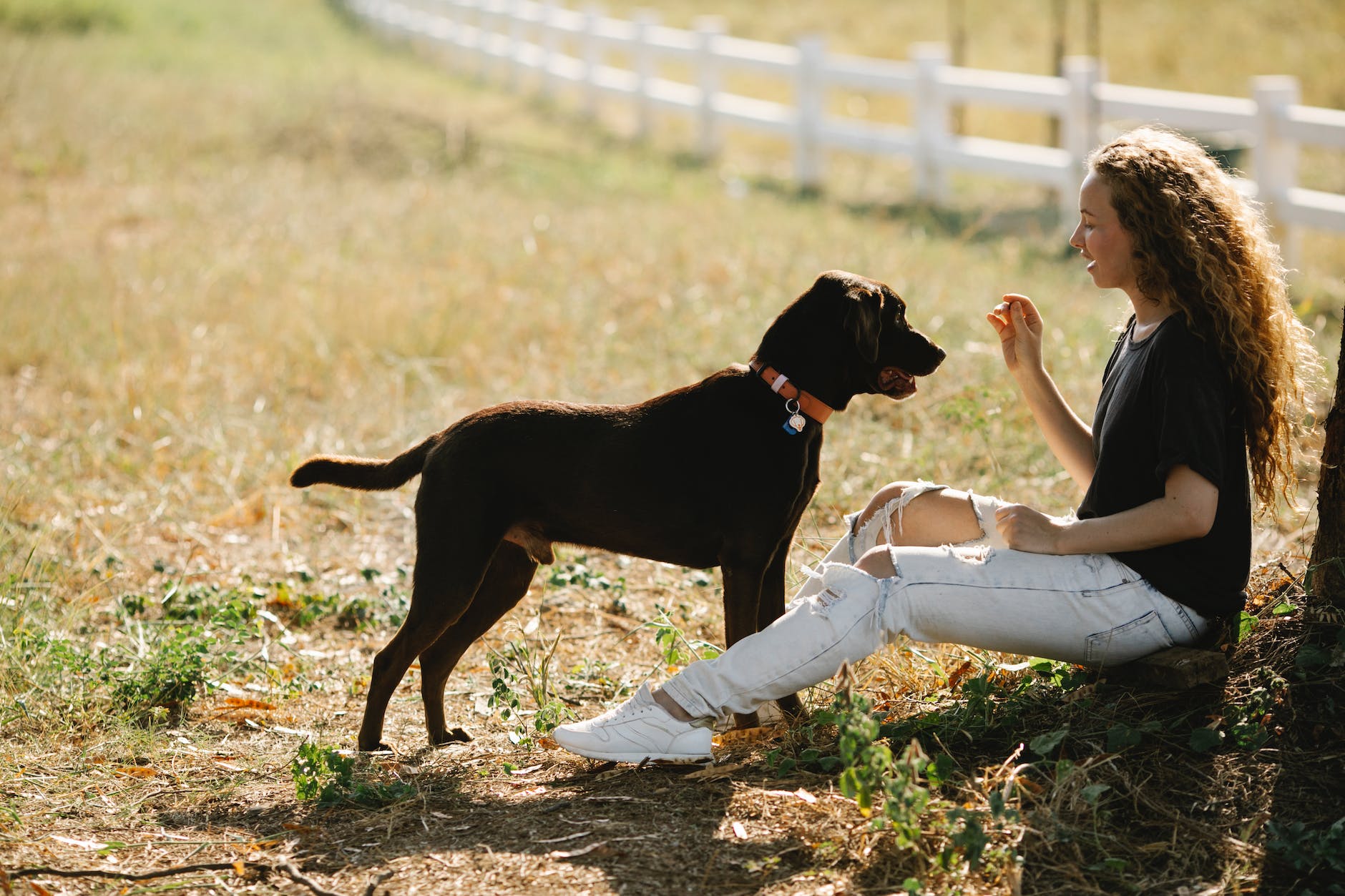How to Train Dog with E Collar
You’ll learn How to Train Dog with E Collar. If you’re a novice dog owner or seeking better training methods, this article will show you how to utilize an e-collar to improve your pet’s behavior. Start this thrilling training adventure together to say goodbye to frustration and hello to a well-behaved and attentive dog!

Understanding E-Collars
Why is an E Collar?
Dog trainers utilize E collars to stimulate dogs quickly and precisely. E collars have a remote control that lets the trainer vibrate or shock the dog’s neck. E-collars reinforce orders, correct bad behavior, and increase owner-pet communication.
How Do E-Collars Work?
The dog’s neck holds the receiver in the collar. The trainer uses a portable remote to manipulate this receiver. The trainer presses a remote button to trigger the receiver on the dog’s collar to offer a command or correct behavior. This signal stimulates the dog with a vibration or moderate electric shock to catch its attention and urge reaction. Always use E collars as part of a full training program and never as a primary mode of communicating with your dog.
Selecting an E Collar and How to Train Dog with E Collar
Consider Dog Size and Weight
Consider your dog’s size and weight before choosing an E collar. E collars come in different sizes, so choose one that fits your dog. A too-large or too-small E collar might be unpleasant and unproductive for your pet. Following the weight and breed standards provided by most E-collar manufacturers will guarantee the collar fits appropriately.
Seek Adjustable Stimulation.
The selection of an E collar should also have the capacity to modify stimulation intensities. Each dog is distinct and sensitive, so being able to adjust stimulus intensity is vital. Look for an E collar with many stimulation settings so you can get the perfect response for your dog.
Consider More Features
While an E collar’s main function is stimulation, several include other functions to improve training. These features may include GPS tracking, remote-controlled LED lighting for nighttime visibility, and sound choices to reinforce orders. Choose an E collar with extra features based on your training goals and dog’s needs.
Prepare Your Dog for E-Collar Training
Train Basic Obedience
Before using an E collar, teach your dog basic obedience. This includes sit, stay, come, and heel. Basic obedience training helps your dog respond to vocal commands, making the E-collar transition easier. If your dog learns these instructions before installing the collar, you may focus on reinforcement rather than introducing a new communication method and fundamental commands.
Introduce Collar Slowly
Introducing a new collar to your dog might be uncomfortable. To ease the adjustment, add the collar gradually. Let your dog sniff and inspect the collar without wearing it. Once your dog is familiar with the collar, carefully put it on their neck for brief intervals. Slowly increase the time until your dog is comfortable wearing the collar.
Dog Collar Conditioning
Your dog must associate the E collar with good events after becoming used to it. Reward your dog with goodies, praise, or playtime when the collar is on or they behave well. Positive association makes the collar a tool for communication and training and helps your dog like it.
Positive collar association
After teaching your dog to the collar, use reward-based training to reinforce the good relationship. Reinforce your dog’s obedience with goodies, praise, or fun with the collar. Positive reinforcement increases your dog-human relationship, making training more fun and successful.

Introducing Stimulation and Commands
Start with Basic Commands
Get your dog used to wearing the E collar and link it with happy events before using it to reinforce fundamental instructions. Start with simple commands like sit or stay for your dog. Give the order and quickly stimulate the E collar. This reinforces your dog’s command knowledge by connecting it to the collar’s response.
Stimulation as reinforcement
Use the E collar’s stimulation to encourage training. If your off-leash dog wanders too far, you may call “come,” and stimulate the collar if they don’t reply. Stimulation reminds and motivates your dog to return and obey. Adjust the stimulation level based on your dog’s response and sensitivity.
Timing Matters
Timing is key when training with an E collar. Give the stimulus soon after a directive or punish bad conduct. This helps your dog link the stimulus with the instruction or activity, boosting their knowledge and attentiveness. Timing consistency helps your dog learn how their activities affect the collar’s response.
Gradually boost stimuli
If your dog becomes used to the E collar and reacts to orders, you may progressively raise the stimulation level. However, go slowly and carefully. Watch your dog’s reaction and only increase the stimulus level if they don’t respond to lesser levels. The idea is to stimulate minimally to get the appropriate response. Overstimulating your dog might stress him out and hamper training.
Positive Reward
Reward-based training
Positive reinforcement is essential to E-collar training. Use alternative reward-based training approaches in addition to the collar’s stimulation. Verbal praise, rewards, and playing are examples. Rewarding your dog will encourage them to repeat the desired behavior. Positive reinforcement builds trust between you and your dog, making training more fun and successful.
Using Rewards and Praise
Rewards and praise are effective positive reinforcement. Treats or passionate praise help your dog know they did well when they followed instructions or behaved nicely. This positive feedback strengthens the link between the intended behavior, the command, and the E collar’s response, making dog training more fun and successful for both of you.
Consistency Matters
Positive reinforcement in E-collar training requires consistency. Reward your dog for good behavior and apply the collar’s stimulation as needed. Consistency helps your dog comprehend expectations and respond to orders faster and more reliably. By preventing confusion and confused messages, consistency makes training easier and more successful.
Avoiding Common Errors
Overusing the E-Collar
Overstimulation is a typical E-collar error. Remember that the E-collar trains not punished. The stimulation reinforces orders and corrects bad behavior, not to punish or hurt your dog. Overusing the E collar might desensitize or frighten your dog, hindering training. Use little stimulus to get the desired response.
Unsuitable Training
Avoid depending on the E collar without proper training. An effective training program with positive reinforcement, regular commands, and clear expectations should accompany the E collar. The collar cannot replace training. Your dog will obey orders if you train it, making the
E-collar is a good reinforcement tool.
Punishment with a Collar
Punishing your dog with the E collar is ineffective and irresponsible. The collar’s stimulation should only reinforce directives or divert undesired actions, not inspire fear or hurt. Positive reinforcement and bonding with your dog should always be priorities in training. Punishing with the collar may be negative and hamper training.
No Positive Reinforcement
Another typical error is not reinforcing the collar’s stimulation. Positive reinforcement increases desired actions and goodwill toward training. Neglecting positive rewards makes dog training less fun, decreasing motivation and progress. Keep a positive training atmosphere by rewarding your dog with goodies and praise for a good performance.
Ensuring Safety and Comfort
Correct Collar Fit
The E collar must fit properly on your dog’s neck for safety and comfort. The collar should fit snugly yet not hinder your dog’s movement. Fit the collar according to the manufacturer’s instructions to avoid injury. As your dog grows or changes weight, check the collar fit to guarantee comfort and security.
Checking and Maintaining
Maintenance and inspection of the E collar are essential for its good operation and lifetime. Look for frayed straps or loose connections on the collar and receiver. The manufacturer recommends cleaning the collar and receiver to eliminate dirt and debris that might hinder performance. Maintaining the collar ensures its efficiency and your dog’s safety throughout training.
Monitoring Dog Behavior and Discomfort
E-collar training requires regular monitoring of your dog’s behavior and discomfort. Watch their body language and responses to orders and stimuli. If the collar causes distress, fear, or strange behavior, stop wearing it and see a trainer or vet. Always put your dog’s comfort and well-being first during training.
Harmonizing E and Regular Collar Use
It’s necessary to use an E collar with a conventional collar during training. Identification tags, leashes, and other daily activities require a normal collar. Not often worn, the E collar is best for training. To keep your dog comfortable and avoid irritation, give them breaks from the E collar.
Seeking Professional Advice
Professional Trainer Consultation
For help using an E collar or teaching your dog, a professional trainer can be invaluable. Professional trainers may help you through the training process, provide tailored advice, and ensure you use the E collar properly. They may address any concerns or behavioral difficulties and suggest dog-specific remedies.
Going to Group Training
Get professional advice and improve your training abilities during group training sessions. Group sessions allow you to work with a professional trainer and other dog owners to watch different training methods, exchange experiences, and learn from each other. It is supportive and participatory, providing insight and helping you manage E-collar training issues.
Treatment for Specific Behavior Issues
If your dog’s behavior isn’t changing with training, get expert help. A professional trainer or animal behaviorist may evaluate your dog’s behavior, determine the causes, and provide a specific training plan to fix it. They can advise you on whether an E collar is right for your dog or whether other training methods are better.
Responsible E-Collar Use
Learning Proper Use
To use an E collar ethically, you must learn how. Research and grasp E-collar training methods and ideas. Learn your E collar’s settings and manufacturer’s directions. Find credible E-collar training knowledge in books or online. You may train your dog more successfully and compassionately with greater information.
Following the manufacturer’s directions
Using an E collar requires following manufacturer instructions. Fitting, charging, and stimulation instructions vary for each collar. The collar’s efficacy and your dog’s safety depend on following these recommendations. Poor use or dog damage may arise from not following the directions. If you have issues regarding the instructions, ask the manufacturer or a trainer.
Understanding E-Collar Limits
E-collars are useful training tools, but they have limits. An E-collar won’t automatically fix all behavioral difficulties. It should be part of a thorough training program that involves positive reinforcement, consistency, and patience. Not all dogs, especially those with anxiety or fear-based behavioral disorders, can use an E collar. To decide if an E collar is suitable for your dog, see a competent trainer.
Alternatives to E-Collars
Training with Positive Reinforcement
Positive reinforcement training works well instead of E collars. These methods stimulate dogs by rewarding desired actions with goodies, praise, or playing. Rewarding excellent behavior and ignoring or redirecting bad conduct can alter your dog’s behavior. Positive reinforcement fosters trust and a deep link between you and your dog.
Clicker Training
Clicker training employs a portable clicker for positive reward. The clicker makes a unique sound when your dog performs a desired activity successfully. Combining the clicker sound with goodies or prizes teaches your dog to link it with good things. Clicker training is a popular and successful alternative to E collars because it provides exact timing and clear communication with your dog.
Reward-based training
to E collars include reward-based training methods. These programs teach dog training through positive reinforcement and give step-by-step instructions. These programs often contain complete training materials, instructional videos, and expert trainers. They provide organized instruction and can help you overcome typical behavioral challenges without E collars.
Finally, knowing and appropriately utilizing an E collar may help train your dog. How to Train Dog with E Collar. You may communicate and positively reinforce desired behaviors with your pet by using correct training strategies, positive reinforcement, safety and comfort, and expert help when needed. Remember, training your dog should be fun and rewarding for both of you, creating a loving and well-behaved companion.
